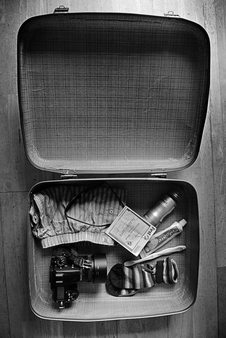
Business trips pose two primary challenges for light packers: looking professional without toting half your wardrobe, and bringing only the most essential gadgets to get the job done.
Unless it's a particularly lengthy trip, you can usually get by with a single neutral-colored suit that can be mixed and matched with different shirts, ties and/or accessories. For example, a woman can wear the same pair of black suit pants for a daytime meeting (pair with a button-down shirt and jacket) and for dinner out (substitute a flowing wrap for the jacket and add earrings or other jewelry to dress up the look). By sticking to neutral colors, you should also be able to keep yourself to a single pair of dress shoes. If you're bringing a blazer or jacket, wear it on the plane to free up space in your carry-on.
iPads and other tablets have helped lighten the load of the business traveler considerably by providing an alternative to bulkier laptops. Don't have a tablet? If it's a short trip, you may be able to get by simply with a smartphone and a trip or two to your hotel's business center or computer kiosk.
If you are attending a conference: Forget about lugging all those folders and freebies you received on the trade show floor. Go through them the night before your departure and pack only what you really need or want. If you still don't have room in your carry-on, have your hotel mail the remaining goodies back to your office.
Rules for Carry-Ons
Here are a few rules of thumb:
1. Limit yourself to two pairs of shoes and two pairs of pants, and wear the heavier items on the plane.
2. Don't pack more than a week's worth of clothes. For longer trips, plan to do laundry along the way.
3. Pack only garments that can be color-coordinated with everything else in your travel wardrobe. If it doesn't work in multiple outfits, leave it at home.
4. Every little bit of space helps. Forget about those "just in case" items you could easily buy in your destination.
5. Many travelers swear by compression bags (also known as Space Bags) to help save precious space -- but keep in mind that they won't help you stay within airline weight limits. (Some carriers do weigh carry-ons.)
6. Maximize your personal item. In addition to a carry-on bag, airlines allow you to bring a personal item such as a purse or laptop bag. I generally bring a small backpack, which can hold a lot more than a purse but will still fit easily under the seat in front of me.
7. Roll your clothes instead of folding them -- it minimizes wrinkles and maximizes space. It might help you save space or a combination of folding and rolling works well.
Unless it's a particularly lengthy trip, you can usually get by with a single neutral-colored suit that can be mixed and matched with different shirts, ties and/or accessories. For example, a woman can wear the same pair of black suit pants for a daytime meeting (pair with a button-down shirt and jacket) and for dinner out (substitute a flowing wrap for the jacket and add earrings or other jewelry to dress up the look). By sticking to neutral colors, you should also be able to keep yourself to a single pair of dress shoes. If you're bringing a blazer or jacket, wear it on the plane to free up space in your carry-on.
iPads and other tablets have helped lighten the load of the business traveler considerably by providing an alternative to bulkier laptops. Don't have a tablet? If it's a short trip, you may be able to get by simply with a smartphone and a trip or two to your hotel's business center or computer kiosk.
If you are attending a conference: Forget about lugging all those folders and freebies you received on the trade show floor. Go through them the night before your departure and pack only what you really need or want. If you still don't have room in your carry-on, have your hotel mail the remaining goodies back to your office.
Rules for Carry-Ons
Here are a few rules of thumb:
1. Limit yourself to two pairs of shoes and two pairs of pants, and wear the heavier items on the plane.
2. Don't pack more than a week's worth of clothes. For longer trips, plan to do laundry along the way.
3. Pack only garments that can be color-coordinated with everything else in your travel wardrobe. If it doesn't work in multiple outfits, leave it at home.
4. Every little bit of space helps. Forget about those "just in case" items you could easily buy in your destination.
5. Many travelers swear by compression bags (also known as Space Bags) to help save precious space -- but keep in mind that they won't help you stay within airline weight limits. (Some carriers do weigh carry-ons.)
6. Maximize your personal item. In addition to a carry-on bag, airlines allow you to bring a personal item such as a purse or laptop bag. I generally bring a small backpack, which can hold a lot more than a purse but will still fit easily under the seat in front of me.
7. Roll your clothes instead of folding them -- it minimizes wrinkles and maximizes space. It might help you save space or a combination of folding and rolling works well.